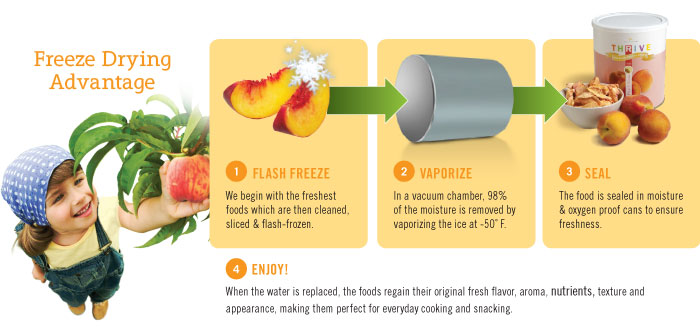One of the oldest forms of food preservation (and one people are very familiar with today) is dehydration. Dehydrated foods do not retain nutrients as well as canning or freezing, but they are still a good way to have fruits vegetables and meats in your long term food storage. They dehydration process basically heats up the food hot enough to remove the moisture but not hot enough to cook it. It produces a dense, heavy, and shriveled form of the item that you dehydrated.
Many people think that freeze-dried foods are the same as dehydrated. However, there are some significant differences between the two processes as well as a big difference in the finished product. Let’s explore the freeze-drying process in more depth.
Freeze-Drying Process
This description of the freeze-drying process comes from ThriveLife.com, a leading producer of freeze-dried foods.
1. Freezing: The product is frozen. This provides a necessary condition for low temperature drying.
2. Vacuum: After freezing, the product is placed under vacuum. This enables the frozen liquid in the product to vaporize without passing through the liquid phase, a process known as sublimation.
3. Heat: Heat is applied to the frozen product to accelerate sublimation.
4. Condensation: Low-temperature condenser plates remove the vaporized liquid from the vacuum chamber by converting it back to a solid. This completes the separation process.

Benefits of Freeze-Dried Foods
HEALTHY: Freeze-drying retains a large percentage of the nutrients from the fresh item. It is the healthiest of all preservation methods.
SHELF LIFE: Since the freeze-drying process removes more moisture than dehydrating, the end result is a food item that has a longer shelf life. Most freeze-dried items can last up to 30 years on the shelf.
LIGHT-WEIGHT: Dehydrated foods shrivel down and become compacted so a #10 can of dehydrated food is very heavy. Freeze-dried foods are the same size as their fresh counterpart, but are a fraction of the weight since all of the moisture is removed. This is beneficial for 72 hour kits when pack weight is a concern.
RETAINS ORIGINAL PROPERTIES: Freeze-dried foods retain their original shape, size, color, flavor, texture, etc. They can be eaten dry or reconstituted. When reconstituted they will be very similar to the fresh item.
EASY TO USE: Freeze-dried foods reconstitute very quickly and do not require cooking. Most dehydrated foods take a long time to rehydrate into a usable form. By using freeze-dried you will save on fuel costs and cook time.
FLAVORFUL: Freeze-dried fruits and vegetables are delicious straight out of the can. They give you a delicious natural flavor and don’t contain all of the preservatives or flavorings that many dehydrated foods do.
Negatives of Freeze-Dried Foods
Because of the more advanced freeze-drying process, most freeze-dried foods tend to be more expensive than their dehydrated counterparts. Also, this is not something that can be done in your home kitchen, so you can’t use your own home grown fruits and vegetables and get a freeze-dried product.

-Jodi Weiss Schroeder
http://foodstoragemadeeasy.net

